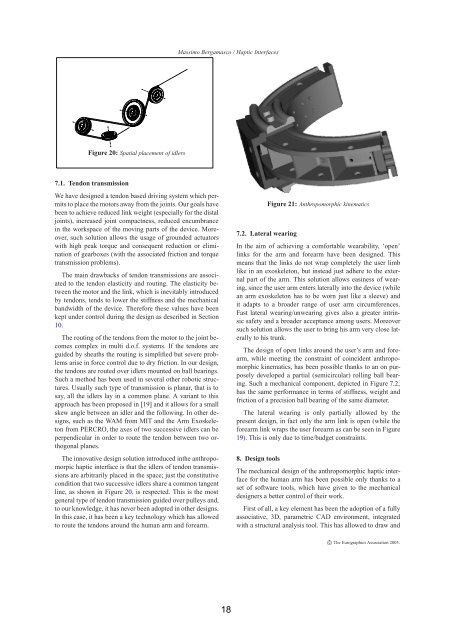full Paper - Nguyen Dang Binh
full Paper - Nguyen Dang Binh
full Paper - Nguyen Dang Binh
Create successful ePaper yourself
Turn your PDF publications into a flip-book with our unique Google optimized e-Paper software.
Figure 20: Spatial placement of idlers<br />
7.1. Tendon transmission<br />
We have designed a tendon based driving system which permits<br />
to place the motors away from the joints. Our goals have<br />
been to achieve reduced link weight (especially for the distal<br />
joints), increased joint compactness, reduced encumbrance<br />
in the workspace of the moving parts of the device. Moreover,<br />
such solution allows the usage of grounded actuators<br />
with high peak torque and consequent reduction or elimination<br />
of gearboxes (with the associated friction and torque<br />
transmission problems).<br />
The main drawbacks of tendon transmissions are associated<br />
to the tendon elasticity and routing. The elasticity between<br />
the motor and the link, which is inevitably introduced<br />
by tendons, tends to lower the stiffness and the mechanical<br />
bandwidth of the device. Therefore these values have been<br />
kept under control during the design as described in Section<br />
10.<br />
The routing of the tendons from the motor to the joint becomes<br />
complex in multi d.o.f. systems. If the tendons are<br />
guided by sheaths the routing is simplified but severe problems<br />
arise in force control due to dry friction. In our design,<br />
the tendons are routed over idlers mounted on ball bearings.<br />
Such a method has been used in several other robotic structures.<br />
Usually such type of transmission is planar, that is to<br />
say, all the idlers lay in a common plane. A variant to this<br />
approach has been proposed in [19] and it allows for a small<br />
skew angle between an idler and the following. In other designs,<br />
such as the WAM from MIT and the Arm Exoskeleton<br />
from PERCRO, the axes of two successive idlers can be<br />
perpendicular in order to route the tendon between two orthogonal<br />
planes.<br />
The innovative design solution introduced inthe anthropomorpic<br />
haptic interface is that the idlers of tendon transmissions<br />
are arbitrarily placed in the space; just the constitutive<br />
condition that two successive idlers share a common tangent<br />
line, as shown in Figure 20, is respected. This is the most<br />
general type of tendon transmission guided over pulleys and,<br />
to our knowledge, it has never been adopted in other designs.<br />
In this case, it has been a key technology which has allowed<br />
to route the tendons around the human arm and forearm.<br />
Massimo Bergamasco / Haptic Interfaces<br />
18<br />
Figure 21: Anthropomorphic kinematics<br />
7.2. Lateral wearing<br />
In the aim of achieving a comfortable wearability, ‘open’<br />
links for the arm and forearm have been designed. This<br />
means that the links do not wrap completely the user limb<br />
like in an exoskeleton, but instead just adhere to the external<br />
part of the arm. This solution allows easiness of wearing,<br />
since the user arm enters laterally into the device (while<br />
an arm exoskeleton has to be worn just like a sleeve) and<br />
it adapts to a broader range of user arm circumferences.<br />
Fast lateral wearing/unwearing gives also a greater intrinsic<br />
safety and a broader acceptance among users. Moreover<br />
such solution allows the user to bring his arm very close laterally<br />
to his trunk.<br />
The design of open links around the user’s arm and forearm,<br />
while meeting the constraint of coincident anthropomorphic<br />
kinematics, has been possible thanks to an on purposely<br />
developed a partial (semicircular) rolling ball bearing.<br />
Such a mechanical component, depicted in Figure 7.2,<br />
has the same performance in terms of stiffness, weight and<br />
friction of a precision ball bearing of the same diameter.<br />
The lateral wearing is only partially allowed by the<br />
present design, in fact only the arm link is open (while the<br />
forearm link wraps the user forearm as can be seen in Figure<br />
19). This is only due to time/budget constraints.<br />
8. Design tools<br />
The mechanical design of the anthropomorphic haptic interface<br />
for the human arm has been possible only thanks to a<br />
set of software tools, which have given to the mechanical<br />
designers a better control of their work.<br />
First of all, a key element has been the adoption of a <strong>full</strong>y<br />
associative, 3D, parametric CAD environment, integrated<br />
with a structural analysis tool. This has allowed to draw and<br />
c The Eurographics Association 2005.
















